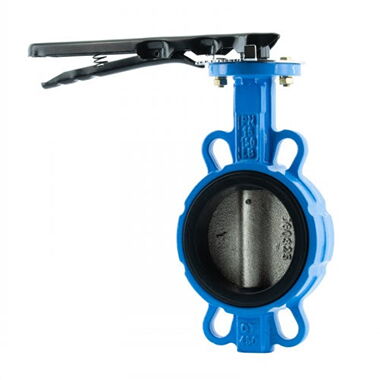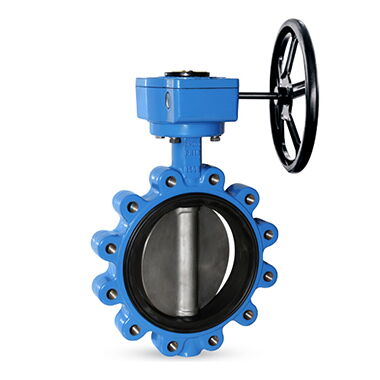Wafer and Lug Butterfly Valve: How to Choose?
Jan 16, 2025
Wafer and Lug butterfly valves are two widely used types of butterfly valves in fluid control systems. Due to their different structures, installation methods, and application scenarios, they each have distinct advantages and areas of suitability. To help users better understand and choose the appropriate butterfly valve type, this article will explore the structural features, installation methods, performance advantages, disadvantages, and application fields of both types. A comparison of their strengths and weaknesses in real-world applications will also be provided.
The design of the wafer butterfly valve is simple and typically consists of a butterfly disc, valve body, and actuator. The core principle is controlling the fluid flow by rotating the butterfly disc within the valve body. The disc is fixed by being connected to a shaft and is controlled by a drive mechanism (usually an electric or pneumatic actuator). When the disc rotates, the flow passage in the valve body narrows or opens, thereby regulating the flow rate. As the valve body has no flange connections at both ends and is simply clamped between two flanges using bolts, it is called a "wafer" valve.

The installation of a wafer butterfly valve is straightforward, requiring no additional flanges or welding processes. The valve is placed between two flanges and fixed with bolts. This installation method is particularly suitable for applications in confined spaces. The disassembly and installation process is relatively simple, saving time and costs during maintenance and replacement.
Cost-Effective: With lower design and production costs, wafer butterfly valves are generally more affordable than lug butterfly valves.
Simple Installation: No additional flanges or special tools are needed, making the installation quick and suitable for standard applications.
Compact Size: Without extra flange connections, wafer butterfly valves have a more compact design, making them ideal for space-limited pipe systems.
Poor Sealing: Compared to lug butterfly valves, wafer butterfly valves are more susceptible to sealing issues in high-temperature, high-pressure, or frequently cycled environments, which may lead to leakage.
Limited Pressure Rating: Typically suited for low-pressure systems, they are not suitable for high-pressure or high-temperature conditions.
Not Ideal for Frequent Disassembly: The simplified flange connection method means that disassembly involves dismantling the connection, which can be inconvenient.
Wafer butterfly valves are widely used in fluid control systems with low pressure and temperature, particularly in medium and small diameter pipelines. Common application fields include:
Municipal water supply and drainage pipelines
Low-pressure sections of oil and gas transmission pipelines
HVAC system duct control
Chemical treatment and water treatment equipment
The installation of a wafer butterfly valve is quick and easy, usually involving the following steps:
Valve Placement: Place the valve between the two flanges, ensuring the valve body aligns with the flange holes.
Bolt Fixing: Insert bolts through the flange holes and secure the valve to the pipeline with bolts and nuts.
Sealing Check: Ensure the sealing surfaces are undamaged and bolts are evenly tightened to avoid leakage.
Valve Position Adjustment: Confirm that the disc can rotate freely without obstruction or friction.
Bolt Tightening: Cross-tighten the bolts to ensure the valve is securely connected and prevent loosening.
Lug butterfly valves have a more complex design than wafer valves, with flanges at both ends featuring lugs. These lugs are equipped with threaded holes or through-holes for connecting to the pipeline flanges. The butterfly disc is usually supported by bearings and connected to the actuator via a shaft. During operation, the disc rotates inside the valve body to control the fluid flow by altering the size of the flow path. The lug design enhances the valve's stability and sealing ability, making lug butterfly valves suitable for high-pressure and high-seal applications.

The installation of a lug butterfly valve is more complicated and usually requires bolts to secure it to the pipeline flanges. It is crucial to ensure that the lugs align perfectly with the pipeline flanges, and precise bolts are used to ensure a tight connection. This method ensures reliable sealing in high-pressure environments and maintains a good sealing effect even under fluctuating pressures.
Better Sealing: Lug butterfly valves provide stronger sealing capabilities compared to wafer butterfly valves due to their bolted connection and lug design, making them suitable for high-temperature and high-pressure conditions.
High Pressure Resistance: The lug design allows the valve to handle higher operating pressures.
Suitable for Frequent Disassembly: The lug design makes maintenance and replacement easier, making it suitable for systems that require regular checks and disassembly.
Complex Installation: Compared to wafer butterfly valves, the installation process is more complex and requires higher precision in bolt connections.
Higher Cost: Due to the more complex design and manufacturing processes, lug butterfly valves are more expensive.
Heavier Weight: The valve is heavier than the wafer butterfly valve, requiring more labor and equipment for installation.
Lug butterfly valves are ideal for high-temperature, high-pressure, and high-seal fluid control systems. They are particularly suitable for:
High-pressure steam pipeline systems
High-pressure fluid control in chemical and petrochemical pipelines
Fluid regulation in thermal and nuclear power plants
Large-diameter pipeline systems
High-pressure sections of oil and gas transmission pipelines
The installation process of a lug butterfly valve is more complex than that of a wafer butterfly valve and typically involves the following steps.
Pre-Inspection: Check that the lugs align with the pipeline flanges and ensure the connection parts are free from defects.
Bolt Insertion: Insert bolts through the flange holes and lug holes, ensuring proper installation direction.
Bolt Tightening: Tighten the bolts alternately in a diagonal sequence to secure the valve to the flanges.
Sealing Check: Ensure there is no leakage between the valve's sealing surface and the pipeline flange.
Valve Position Adjustment: Ensure the disc can rotate freely and adjust the actuator control mechanism.
Final Inspection: Conduct a sealing test to ensure smooth operation and no leakage.
When selecting between a wafer butterfly valve and a lug butterfly valve, it is essential to consider their characteristics in various aspects. Below is a comparison based on installation and maintenance, cost and performance.
Wafer Butterfly Valve: Installation is simple, ideal for applications with limited space and no frequent disassembly. Maintenance and replacement are easy, but sealing and pressure resistance are relatively weaker.
Lug Butterfly Valve: Installation is more complicated and requires precise bolt connections. It is suitable for high-seal and high-pressure environments. Although installation is more intricate, its high stability and pressure resistance make it ideal for demanding conditions.
Wafer Butterfly Valve: With a simple structure and low cost, it is suitable for medium and low-pressure standard applications. Its performance is basic, mainly fulfilling economic requirements.
Lug Butterfly Valve: Due to its more complex design and manufacturing process, the lug butterfly valve is more expensive, but it offers stronger sealing and pressure resistance, making it suitable for more demanding conditions.
The choice of butterfly valve type should be based on specific application needs, pressure rating, installation space, and budget. For lower-pressure environments with limited space, the wafer butterfly valve is a cost-effective and convenient choice. On the other hand, if higher sealing, pressure resistance, and stable operation under high-temperature and high-pressure conditions are required, the lug butterfly valve is the better option.
Next: Sealing Solutions for High-Temperature Ball Valves
Previous: Valve Selection for Flammable and Explosive Media
